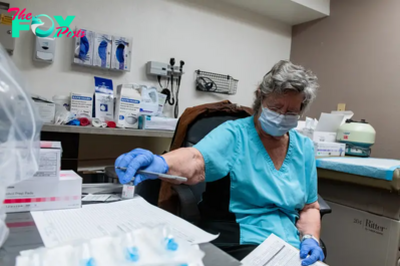Health
Colorado looks to get lead out of aviation fuel as a new study adds to potential health concerns
The gas you put in your car has an octane rating between 85 and 91 in Colorado, but, to get off the ground, airplanes need a little more oomph.
Standard aviation fuel for piston-engine aircraft — think Cessnas and other small planes — has an octane rating of at least 100. But that extra pop comes with a price: The fuel typically has lead in it.
This means, as planes burn that fuel, lead pollution gets released into the air and falls to the ground, where humans can breathe it in. And this, of course, is bad, as lead poisoning can cause numerous health problems, especially in young kids.
The issue has been a hot one for years for communities living near airports in Colorado. But now, a new study by the state Health Department is providing a fresh look at the scope of the problem, while a recently passed bill at the state legislature seeks to nudge airports along in their switch to unleaded fuel.
“This is a very contentious issue in my community,” said state Rep. Kyle Brown, a Democrat whose district includes parts of Boulder County that abut Rocky Mountain Regional Airport. “It’s really acute. Folks in my community, in Superior, have homes that are under the flight pattern.”
New analysis on lead levels in kids
The Colorado Department of Public Health and Environment has conducted an analysis showing higher-than-average levels of lead in the blood of children living close to airports, but the levels still fall below federal standards.
The analysis has not yet been released officially, but Dr. Ned Calonge, CDPHE’s chief medical officer and an expert on lead screening, provided Westminster City Council members a briefing on the analysis during a study session in March. Calonge said the analysis is being peer-reviewed for future publication, and CDPHE officials declined multiple requests from The Sun to make Calonge available for a follow-up interview, saying they wanted to wait until the peer-review process is complete.
CDPHE’s study looked at existing data on blood lead levels in people under the age of 18 who live within 5 miles of an airport in the state and then grouped the results by the more precise distance they live from the airport.
Twelve airports were included in the study, and the results were aggregated for all airports — meaning the study can’t say whether kids living near a specific airport have higher lead levels than kids living near another. The study also did not make any findings about the levels of lead in the environment around the airports, and it didn’t provide any other information about the kids’ health.
The average blood lead level for kids in the study was 2.08 micrograms per deciliter. But, within 3 miles of an airport, that level creeps above average, while it drops below average outside of 3 or more miles away.
Children living within 2 miles of an airport have a blood lead level of 2.19 micrograms per deciliter, and children living within a half-mile have a level of 2.29 micrograms per deciliter, according to the study.
There is no safe level of lead in the blood. But the Centers for Disease Control and Prevention’s “reference level” for lead — meaning the measure the federal government uses to assess whether a child has an especially concerning blood lead level — is 3.5 micrograms per deciliter.
☀️ READ MORE
Colorado receives $32.8 million to replace decades-old lead pipes and improve drinking water systems
Colorado abortion providers are receiving influx of calls from Floridians after the state’s May 1 ban took effect
Does Colorado allow abortions even after birth?
Calonge told Westminster council members that the study’s findings ultimately show that Colorado is succeeding at limiting kids’ exposure to lead. In the 1970s, before lead-based paint and lead in gasoline were banned, pediatric blood lead levels in Colorado averaged above 10 micrograms per deciliter.
“Everything that we have done in lead abatement and in addressing lead issues is working, and we are driving blood lead levels down over time,” Calonge said.
People can also be exposed to lead in the soil, and Calonge said lead-based paint in older homes remains the state’s biggest exposure source.

Continued controversy
Calonge’s comments didn’t satisfy all Westminster council members.
Council member Obi Ezeadi called CDPHE’s analysis a “black box” for trying to assess the risk from Rocky Mountain Metropolitan Airport, or RMMA, which sits just north of the city. Other council members raised concerns about what Calonge acknowledged are relatively meager testing rates, which could be hiding more worrisome data.
“We won’t know the impact of RMMA unless we have specific testing done there,” council member Amber Hott said.
Their concerns add to a litany of complaints against the airport by surrounding communities. The town of Superior and the Boulder County commissioners earlier this year sued Rocky Mountain Metropolitan Airport over complaints about practices that could increase lead pollution. Health leaders have spoken out on the issue.
-

 Health4h ago
Health4h agoThe Surprising Benefits of Talking Out Loud to Yourself
-

 Health5h ago
Health5h agoDoctor’s bills often come with sticker shock for patients − but health insurance could be reinvented to provide costs upfront
-

 Health20h ago
Health20h agoWhat an HPV Diagnosis Really Means
-

 Health1d ago
Health1d agoThere’s an E. Coli Outbreak in Organic Carrots
-

 Health2d ago
Health2d agoCOVID-19’s Surprising Effect on Cancer
-

 Health2d ago
Health2d agoWhat to Know About How Lupus Affects Weight
-

 Health5d ago
Health5d agoPeople Aren’t Sure About Having Kids. She Helps Them Decide
-

 Health5d ago
Health5d agoFYI: People Don’t Like When You Abbreviate Texts


























